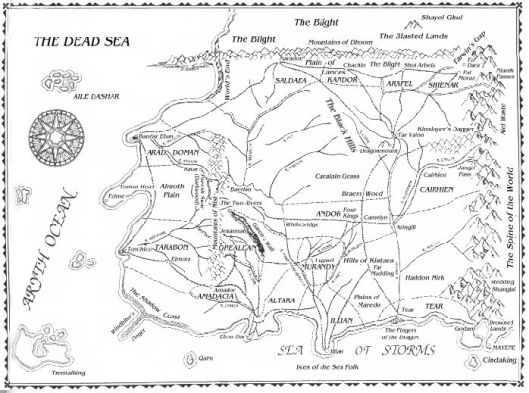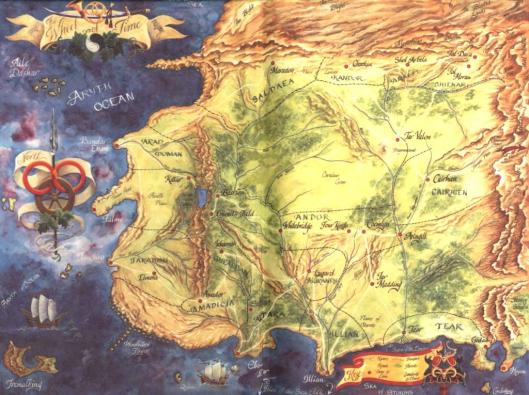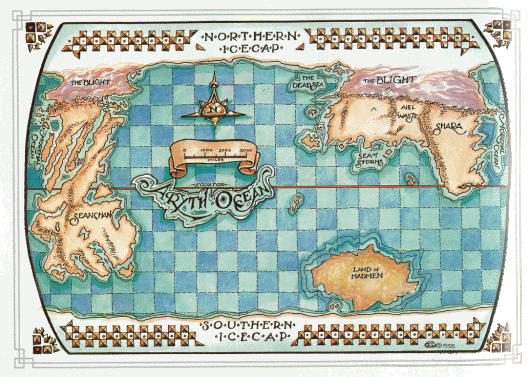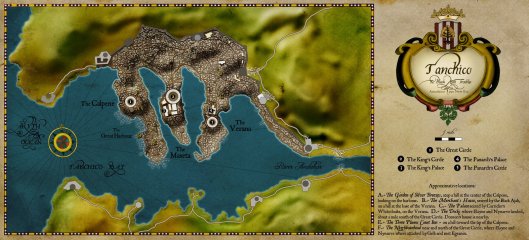The Wheel of Time is the biggest-selling epic fantasy series to appear since The Lord of the Rings. Published between 1990 and 2013, the series comprises fourteen main-series novels, a spin-off prequel novel, two companion volumes, a CD soundtrack, a video game and a pen-and-paper roleplaying game (and sourcebook). Approximately 90 million copies of the books have been sold (and rising) to date, and earlier this year it was confirmed that a production company had picked up the rights to the series with the goal of developing a big-budget TV series. George R.R. Martin has stated that it was Robert Jordan’s cover blurb and favourable reviews which helped drive sales of A Game of Thrones back in 1996.

One of the earliest Wheel of Time maps, notably lacking in fine detail.
Sadly, author Oliver Rigney Jr. (Robert Jordan was a pen name) passed away in 2007 whilst working on the ending to the series. Up-and-coming fantasy author Brandon Sanderson was picked to conclude the series and did so in fine form, using Robert Jordan’s notes where available.
Apparently Robert Jordan did not originally plan to include maps in the books, and did so only at the urging of his publisher Tom Doherty because people expected maps in a fantasy novel. This may be why the earliest maps for the books were pretty bare-bones, only featuring the names of the major countries, the two big mountain ranges and not much else. It may also explain the curiously straight mountain range edges to the map border which later came in for much ribbing from reviewers.

Ellisa Mitchell’s highly-praised full-colour map of the Westlands continent. It first appeared in Lord of Chaos (1994) and subsequently appeared in the inside cover of every hardcover volume of the series.
However, Jordan later paid a much more attention to the maps and fleshed them out with a lot more detail. In 1994, the sixth volume in the series, Lord of Chaos, shipped with a beautiful full-colour map on the inside cover from artist Ellisa Mitchell which appeared in all subsequent volumes.

The first-ever world map. It was published in The World of Robert Jordan’s The Wheel of Time (1997).
In 1997 Tor Books released The World of Robert Jordan’s The Wheel of Time, aka “The Big White Book” for its distinctive appearance. This book featured the first map of the entire world and the first (and only) official maps of the continents of Seanchan and Shara. These maps, drawn by Tom Canty and John M. Ford, were not tremendously detailed and apparently did not completely adhere to Robert Jordan’s descriptions, but due to art budget limitations and time constraints they were not redrawn before publication.
Later Jordan shared his notes for the maps from the book, which among other things confirm that the Seanchan continent was supposed to be considerably larger than it appeared in this volume:
- The world of the books is the same size as our world. After all, it’s supposed to be our world, with all the tectonic plates shifted. Some reference points:
- Illian is about 2,500 miles south of Chachin, and 2,700 miles south of the Mountains of Dhoom.
- Falme to the Spine of the World is about 3,300 miles.
- Falme to Seanchan across the Aryth Ocean is about 11,000 miles.
- Seanchan to Shara across the Sea of Omerna (presumably an early name for the Morenal Ocean) is about 3,000 miles.
- The Aiel Waste is about 1,200 miles across, while Shara is about 2,000 miles (W-E) by 5,000 miles (N-S), with the Great Blight extending further south in Shara than in the Borderlands.
- Seanchan is about 16,000 miles from the southern tip to the Mountains of Dhoom (named by Hawkwing’s armies) in the north—yes, the same mountain range that girdles the world on land and under the ocean. The north of Seanchan is about 2,000 miles across at its widest, and there is a span of 6,000 miles at its widest in the south.
- South of the known world is an island continent known only to the Sea Folk, but avoided by them, which they call “the Land of the Madmen.” Its dimensions are about 3,000 miles (W-E) by 2,000 miles (N-S), with its southern coast less than 500 miles from the southern ice cap in places. Some speculate on the resemblance of this continent, in all respects, to current-day Australia, but on this we have no opinion.
- There are both northern and southern ice caps. The southern ice cap completely covers whatever land is beneath it, and is larger than Antarctica. The northern ice cap also stretches somewhat further south than in our world.
- And to cap off this post, we note that some of the early maps were sketched out by Mike Ford, and others drawn by Thomas Canty; but the later maps throughout the series are the work of Ellisa Mitchell, a talented artist whose clarity of vision and attention to detail have been responsible for helping us imagine the major cities that have appeared in the story.

The only canon map of Illian to be published, in The Wheel of Time Roleplaying Game (2001). Art by Ellisa Mitchell.
Ellisa Mitchell provided new and more detailed colour city maps for The Wheel of Time Roleplaying Game (2001) and its sourcebook, Prophecies of the Dragon (2002), both from Wizards of the Coast. These included the first and only canonical maps of the key cities of Tear and Illian.
Fan maps for Wheel of Time are, surprisingly, thin on the ground. There are some decent fan recreations but professional-style cartographers don’t seem to be major fans of the series in the same way they are for Dungeons and Dragons, Lord of the Rings or A Song of Ice and Fire.

A map of the city of Tanchico and surrounds, taken from the excellent Thirteenth Depository blog.
A notable exception are the team at Thirteenth Depository, a fan site featuring some excellent original maps dedicated to clearing up the sometimes-confused geographic descriptions in the novels. The site is no longer regularly updated, but the maps can still be seen there.
The Wheel of Time seems particularly ripe for exploration through an official fantasy atlas of some kind, and it’d be great to see such a book some time. Unfortunately, the recent Wheel of Time Companion (2015) was lacking in the way of more geographical information or new maps for this world. If the TV series does happen and is popular, hopefully that will generate more of a market for such a book.

That should make for some interesting climate patterns. The Westlands have mountains on three sides, and probably should be pretty dry unless they’ve got some potent storms coming up from the south (probably the case, given it’s called the Sea of Storms). Shara should probably be a bit on the dry side as well, given that it’s “only” 3000 miles. There’s less open sea for storms to build up on.
LikeLike
yeah it doesnt really make sense geologically or in terms of climate. I can excuse it a bit because theres magic (the land of madmen lies to the south and who knows how their activity contributes to climate on the planet), but this world is our world… so therefore these continents and landmasses must somehow conform to – or be able to be translated to – our current day geography. Im curious if you can see a way to map this translation, since you seem more well versed in this stuff than I am. One theory ive seen floated is that the world was tilted or flipped during the breaking, so everything is rotated 90 or 180 degrees. Any thoughts on that? Ive never been able to make it work in my head (other than australia being the land of madmen haha)
LikeLike